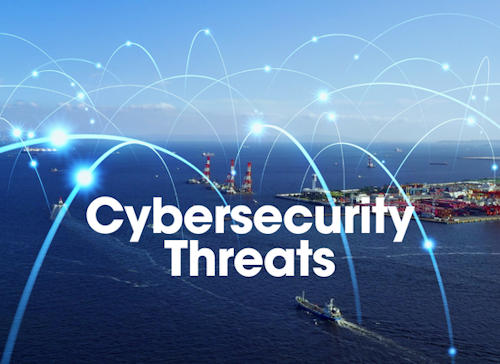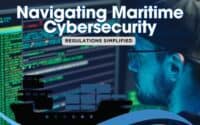Cybersecurity: The Top 10 Threats Facing the Maritime Industry

The maritime industry is a vital part of global trade and commerce, with millions of vessels, containers, and crew members relying on complex systems and technologies to navigate the world’s oceans. However, this increasing reliance on technology has also introduced a new range of cybersecurity risks, threatening the safety, security, and efficiency of maritime operations. As the industry continues to digitalize, it’s essential to understand the top cybersecurity threats facing maritime organizations, and take proactive steps to mitigate these risks and protect against cyber-attacks.
* Please send feedback/suggestions to editor @ shipuniverse.com
1. Phishing Attacks
Phishing attacks are a common cyber threat in the maritime industry, targeting crew members, shore-based staff, and other stakeholders. Cybercriminals send fraudulent emails or messages that appear legitimate, aiming to trick victims into revealing sensitive information such as login credentials, financial information, or personal data. Phishing attacks can lead to:
- Unauthorized access to sensitive systems and data
- Malware installation and ransomware attacks
- Financial losses and identity theft
- Compromised safety and security of vessels and crew
2. Ransomware Attacks
Ransomware attacks involve malware that encrypts critical data, rendering it inaccessible until a ransom is paid. In the maritime industry, ransomware attacks can have devastating consequences, including:
- Disruption of vessel operations and navigation systems
- Loss of sensitive data, including cargo manifests and crew personal information
- Financial losses due to ransom payments and downtime
- Compromised safety and security of vessels, crew, and cargo
3. Unsecured IoT Devices
The increasing use of Internet of Things (IoT) devices in the maritime industry, such as sensors, cameras, and smart appliances, has expanded the attack surface. Unsecured IoT devices can be easily exploited by cybercriminals, allowing them to:
- Gain unauthorized access to sensitive systems and data
- Launch distributed denial-of-service (DDoS) attacks
- Spread malware and ransomware
- Compromise the safety and security of vessels and crew
4. Supply Chain Attacks
The maritime industry relies heavily on a complex supply chain, which can be vulnerable to cyber attacks. Supply chain attacks involve targeting third-party vendors, contractors, or service providers to gain access to sensitive systems and data. These attacks can lead to:
- Data breaches and intellectual property theft
- Disruption of operations and logistics
- Financial losses and reputational damage
- Compromised safety and security of vessels, crew, and cargo
5. Navigation and Communication System Attacks
Cyber attacks on navigation and communication systems, such as GPS, ECDIS, and VHF, can have severe consequences for vessel safety and operations. These attacks can:
- Disrupt navigation and collision avoidance systems
- Interfere with communication systems, including emergency distress calls
- Manipulate vessel positioning and tracking data
- Compromise the safety of vessels, crew, and cargo
6. Insider Threats
Insider threats come from individuals with authorized access to maritime systems, data, or facilities. These threats can come from current or former employees, contractors, or other insiders who intentionally or unintentionally cause harm. Insider threats can:
- Result in data breaches and intellectual property theft
- Disrupt vessel operations and navigation systems
- Cause physical damage to vessels, equipment, and facilities
- Compromise the safety and security of vessels, crew, and cargo
7. Vulnerabilities in Legacy Systems
The maritime industry relies on legacy systems, such as older navigation and communication equipment, which can be vulnerable to cyber attacks. These systems may have outdated software, unpatched vulnerabilities, and inadequate security configurations, making them an attractive target for cybercriminals. Exploitation of these vulnerabilities can:
- Disrupt vessel operations and navigation systems
- Compromise sensitive data and intellectual property
- Allow unauthorized access to systems and data
- Put the safety of vessels, crew, and cargo at risk
8. Physical Security Breaches
Physical security breaches can provide cybercriminals with access to sensitive areas, systems, and data. Examples include:
- Unauthorized access to vessel bridges or control rooms
- Tampering with equipment or installing malware-infected devices
- Theft of sensitive documents or devices
- Physical damage to vessels, equipment, or facilities
9. Social Engineering Attacks
Social engineering attacks manipulate individuals into divulging sensitive information or performing certain actions that compromise security. In the maritime industry, social engineering attacks can:
- Trick crew members into revealing sensitive information or login credentials
- Convince shore-based staff to install malware or divulge sensitive data
- Manipulate vendors or contractors into compromising security protocols
- Lead to physical security breaches or unauthorized access to vessels
10. Lack of Cybersecurity Awareness and Training
The maritime industry’s cybersecurity posture is only as strong as its weakest link – its people. A lack of cybersecurity awareness and training can lead to:
- Unintentional mistakes and oversights
- Failure to recognize and report suspicious activity
- Inadequate response to cybersecurity incidents
- Compromised security and safety of vessels, crew, and cargo
The maritime industry faces a diverse range of cybersecurity threats, from phishing attacks and ransomware to physical security breaches and lack of awareness. By understanding these threats and taking proactive measures to address them, maritime organizations can reduce the risk of cyber-attacks, protect their assets and data, and ensure the safety and security of their crew, vessels, and operations. It’s time for the maritime industry to take cybersecurity seriously and make it a top priority – the future of global trade and commerce depends on it.

Do you have a Maritime Product or Service that may be of interest to Shipowners? Tell us about it here!
Do you have feedback or insights? Please reach out to editor @ shipuniverse.com



